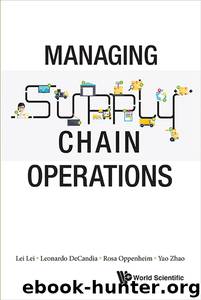Managing Supply Chain Operations by Leonardo DeCandia & Rosa Oppenheim & Yao Zhao

Author:Leonardo DeCandia & Rosa Oppenheim & Yao Zhao
Language: eng
Format: epub
ISBN: 9789813108813
Publisher: World Scientific Publishing Company
Published: 2017-04-15T00:00:00+00:00
Figure 4.3:A Hypothetical Supply Chain.
Figure 4.4:Area of Demand Surge from Hurricane Irene.
Source: www.noaa.gov
The fact that a forecast cannot always be 100% accurate reflects the reality that uncertainty exists everywhere in a supply chain network. In general, both demand and supply cannot be fully predicted; for example, demand surge, price variation, and random lead times will impact the demand to supply balance. As an example, Figure 4.4 shows the path of 2011’s Hurricane Irene, causing an unexpected demand surge at the retail level as people prepared by stocking up on necessities. The objective of safety stock is to buffer against uncertainties so that one can almost always satisfy demand. The accuracy of the forecast, the quality of the supply execution and the level of risk tolerance are important factors in determining the level of safety stock required.
Pipeline Stock. Production can be subject to lengthy and unexpected delays, particularly in global and complex supply chain networks that also include shipping over a large distance, where operations are subject to, for example, strikes, mechanical breakdowns, adverse weather conditions, security inspections. For instance, the shipping time from a factory in South East Asia to a distribution center in the US is at least 4–6 weeks. The shipping cycle time includes inland transportation on both ends, ocean transportation (around 10 days), and port operations. The shipping time from Europe to the US is slightly shorter because ocean transportation takes about 5 days, but the other elements, including customs clearance and any duty requirements, are similar. As the shipping time increases, shipments spend longer time in transit; pipeline stock provides a buffer against shortages due to anticipated delayed transit and production times, and factors in the transportation cycle time around the inventory modeling. The longer the transportation cycle time for replenishment, the higher the inventory.
Prebuilt Stock. Seasonal demand is common and most companies do not have the production capacity to meet demand during the peak season. For this reason, most retailers build up inventory well before, say, the Christmas season demand (which can represent over 60% of annual sales for many companies) and optimize capacity efficiency with inventory costs throughout the calendar year. Other examples of seasonal inventory build-up, or prebuilt stock, include barbecue grills for the summer season, snow blowers for the winter season, candy for Halloween, flu vaccines for early autumn, and power generators for hurricane seasons. Products are produced and delivered to the stock-keep locations based upon the forecasts and business plans. Success is measured against meeting the true demand at each location with the correct inventory to support that demand.
Forward-buy Stock. The procurement cost of inventory can vary significantly over time due to temporary discounts, capacity utilization, and price promotions offered by suppliers. To hedge against future cost inflation, some companies may buy more supplies than what is needed to satisfy short-term demand and carry them in inventory. Stock carried for such reasons is called forward-buy stock or investment-buy stock. It is also called speculative-buy stock if the cost inflation is not completely predictable.
Download
This site does not store any files on its server. We only index and link to content provided by other sites. Please contact the content providers to delete copyright contents if any and email us, we'll remove relevant links or contents immediately.
Hit Refresh by Satya Nadella(8983)
The Compound Effect by Darren Hardy(8719)
Change Your Questions, Change Your Life by Marilee Adams(7546)
Nudge - Improving Decisions about Health, Wealth, and Happiness by Thaler Sunstein(7442)
The Black Swan by Nassim Nicholas Taleb(6925)
Deep Work by Cal Newport(6793)
Daring Greatly by Brene Brown(6356)
Rich Dad Poor Dad by Robert T. Kiyosaki(6298)
Principles: Life and Work by Ray Dalio(6102)
Man-made Catastrophes and Risk Information Concealment by Dmitry Chernov & Didier Sornette(5862)
Playing to Win_ How Strategy Really Works by A.G. Lafley & Roger L. Martin(5704)
Digital Minimalism by Cal Newport;(5570)
Big Magic: Creative Living Beyond Fear by Elizabeth Gilbert(5541)
The Myth of the Strong Leader by Archie Brown(5358)
The Slight Edge by Jeff Olson(5309)
Discipline Equals Freedom by Jocko Willink(5229)
The Motivation Myth by Jeff Haden(5113)
Stone's Rules by Roger Stone(4981)
The Laws of Human Nature by Robert Greene(4909)
